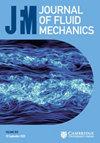自由表面湍流中的相对弥散
IF 3.9
2区 工程技术
Q1 MECHANICS
引用次数: 0
摘要
我们报告了一项实验研究,该研究将拉格朗日跟踪技术应用于漂浮在湍流水自由表面上的数百万个微观粒子。我们利用了一个大型喷射搅拌零均值流装置,在该装置中,雷诺数足够高,可以出现惯性范围,而表面变形仍然很小。两点统计揭示了流动的具体特征,偏离了不可压缩湍流的经典描述。相对速度的大小具有很强的间歇性,特别是在小的分离范围内,这导致二阶结构函数在耗散范围内的异常缩放。这是由流动的发散成分驱动的,导致附近粒子的快速接近/分离率。拉格朗日相对速度显示出初始状态的强烈持久性,从而使弹道对分离延伸到时间延迟的惯性范围。根据这些观察结果,我们提出了一种基于粒子对初始分离率的粒子对分类方法。当相对速度远小于惯性缩放所规定的相对速度时(大多数观测到的粒子对都是这种情况),相对速度会过渡到扩散增长,并恢复理查森-奥布霍夫超扩散色散。本文章由计算机程序翻译,如有差异,请以英文原文为准。
Relative dispersion in free-surface turbulence
We report on an experimental study in which Lagrangian tracking is applied to millions of microscopic particles floating on the free surface of turbulent water. We leverage a large jet-stirred zero-mean-flow apparatus, where the Reynolds number is sufficiently high for an inertial range to emerge while the surface deformation remains minimal. Two-point statistics reveal specific features of the flow, deviating from the classic description derived for incompressible turbulence. The magnitude of the relative velocity is strongly intermittent, especially at small separations, leading to anomalous scaling of the second-order structure functions in the dissipative range. This is driven by the divergent component of the flow, leading to fast approaching/separation rates of nearby particles. The Lagrangian relative velocity shows strong persistence of the initial state, such that the ballistic pair separation extends to the inertial range of time delays. Based on these observations, we propose a classification of particle pairs based on their initial separation rate. When this is much smaller than the relative velocity prescribed by inertial scaling (which is the case for the majority of the observed particle pairs), the relative velocity transitions to a diffusive growth and the Richardson–Obukhov super-diffusive dispersion is recovered.
求助全文
通过发布文献求助,成功后即可免费获取论文全文。
去求助
来源期刊
CiteScore
6.50
自引率
27.00%
发文量
945
审稿时长
5.1 months
期刊介绍:
Journal of Fluid Mechanics is the leading international journal in the field and is essential reading for all those concerned with developments in fluid mechanics. It publishes authoritative articles covering theoretical, computational and experimental investigations of all aspects of the mechanics of fluids. Each issue contains papers on both the fundamental aspects of fluid mechanics, and their applications to other fields such as aeronautics, astrophysics, biology, chemical and mechanical engineering, hydraulics, meteorology, oceanography, geology, acoustics and combustion.

 求助内容:
求助内容: 应助结果提醒方式:
应助结果提醒方式:


